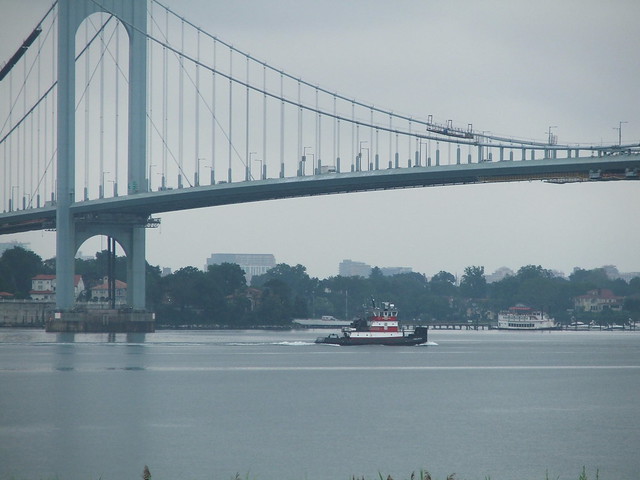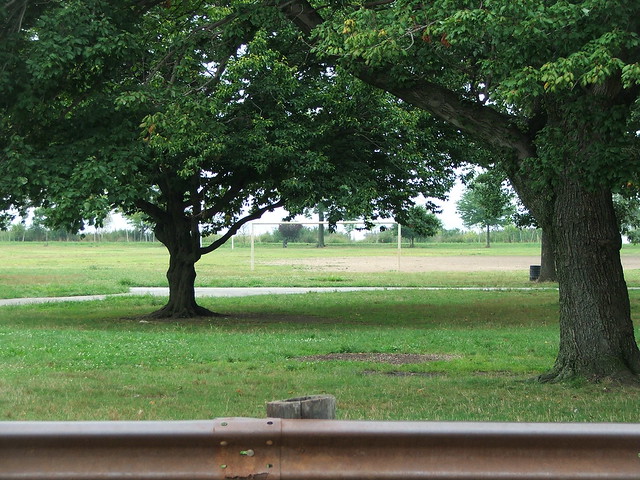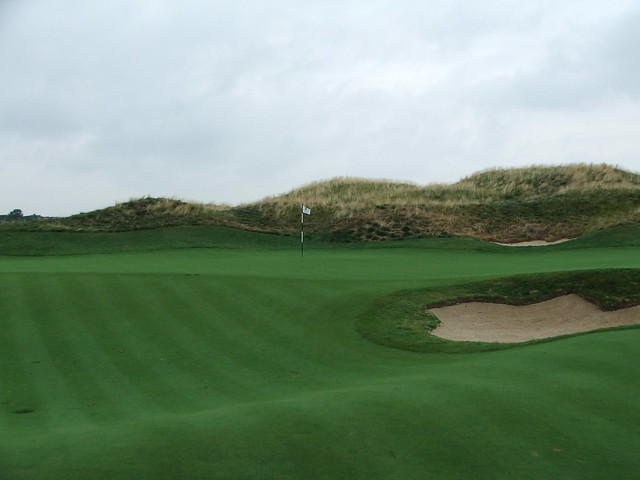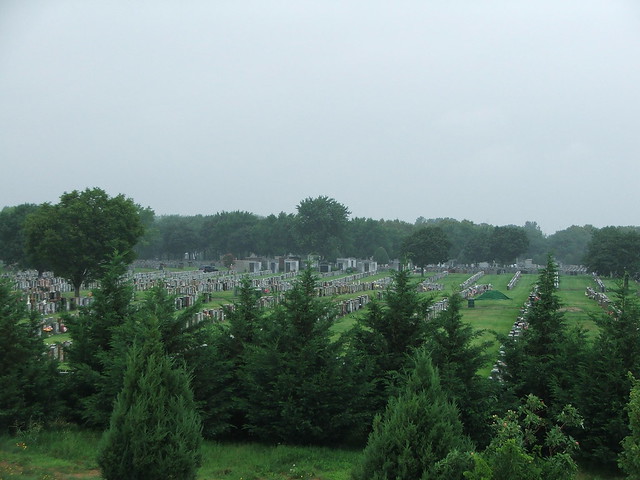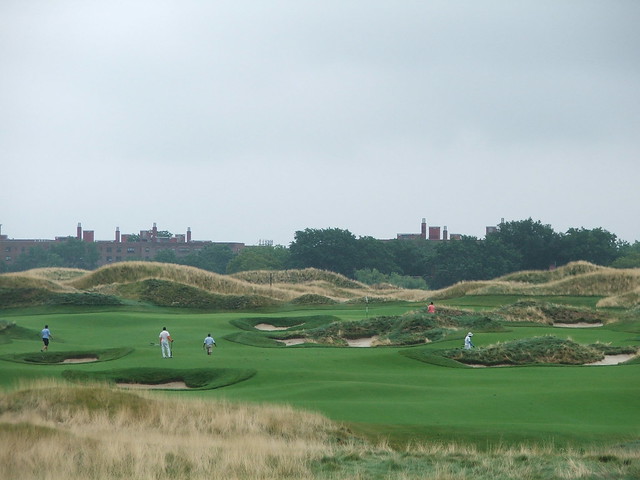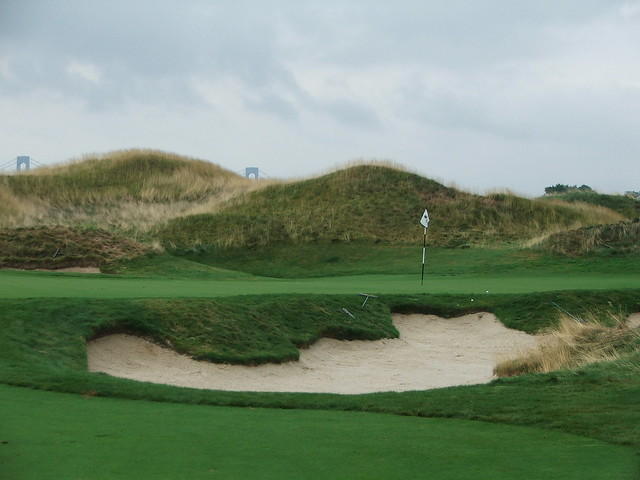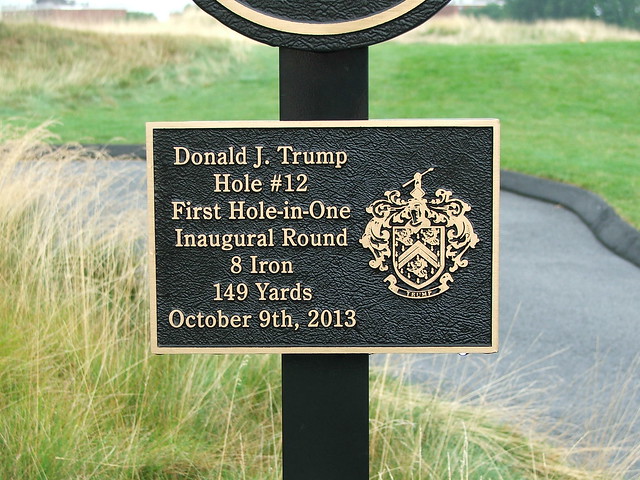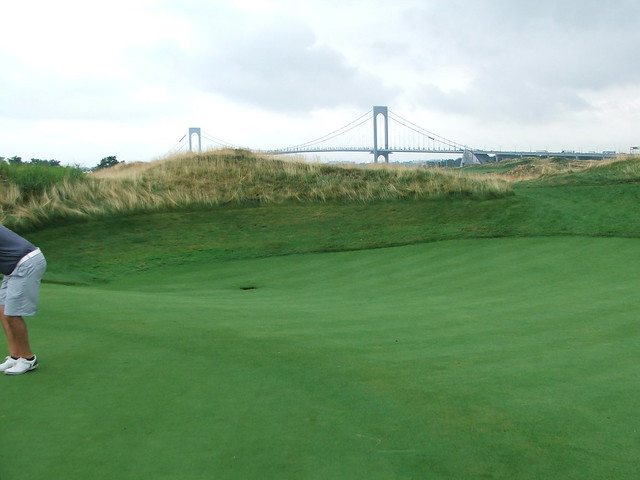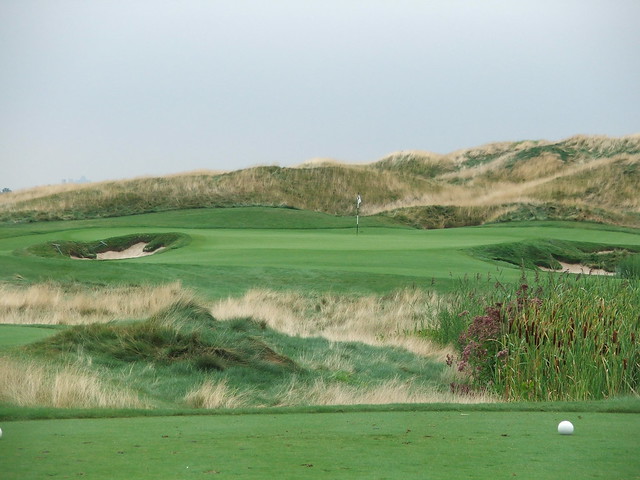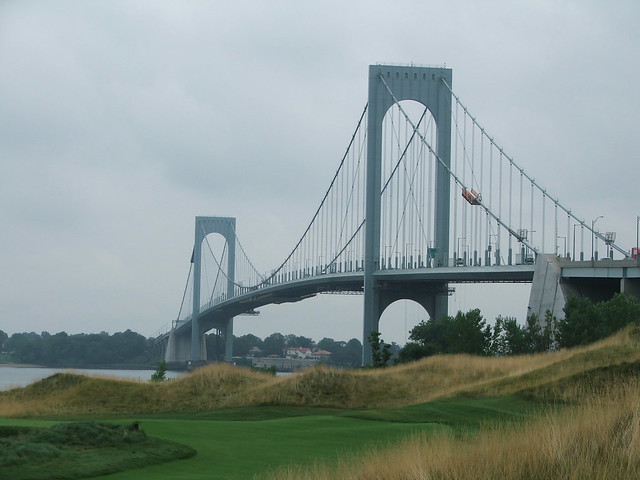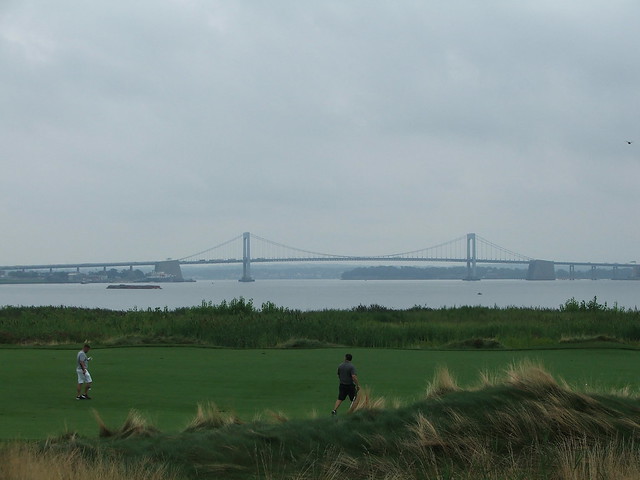The Bronx doesn't get enough respect. The fact that it now has a quality golf course, maintained in top condition, designed by one of the game's greats is something to celebrate! The course is the first new one in New York City since Lyndon Johnson was president and this in itself is a huge accomplishment.
A tug boat passing under the Bronx-Whitestone bridge on the East River as seen from the 16h hole at Trump Ferry Point Golf Links
The charms of the Bronx are very often overlooked: the magical 700 acre Botanical Garden, Fordham University, Van Cortlandt Park (which is 400 acres larger than Central Park), Manhattan College, the authentic atmosphere and food of Arthur Avenue's Italian neighborhood, Yankee Stadium, and more. I remember the excitement as a kid when we would get loaded onto the bus for a field trip to the amazing Bronx Zoo. Visiting the largest zoo in the country was always a day to remember because it was the only time we were allowed to bring gum and snacks on the bus.
Natives sons and daughters of the Bronx are an impressive group: Alan Alda, the greatest baseball announcer in history Vin Scully, Ed Koch, James Caan, Regis Philbin, and Lauren Bacall. The list of people who lived in the Bronx is equally as impressive: Edgar Allan Poe, Lou Gehrig, Woody Allen, John F. Kennedy (can you believe he lived in the borough from 1927-1929?), Al Pacino, Mark Twain and Stanley Kubrick, to name just a few.
The Bronx also played an important role in the evolution of golf. The first public golf course in the United States was in the borough: the Van Cortlandt Park Golf Course, which opened for play in 1895. Babe Ruth, Jackie Robinson, Harry Vardon, Joe Louis, Willie Mays, Sidney Poitier, and the Three Stooges all played at Van Cortlandt. The golf course was revitalized during the Giuliani administration and is today a respectable course kept in good condition.
Because of the name preceding the Ferry Point course I know it is difficult to talk about without getting into politics. This is a golf blog and not one that covers the Donald so to the degree that I can I will stay away from politics. The Trump organization operates the course under a twenty year lease with the city and their commitment includes investing $10 million to build the greatest clubhouse that will ever be built. I know there is much criticism about the deal, although I will say that Michael Bloomberg is no dummy and he was mayor when it was signed, so I'm not sure it's a bad a deal on balance as some people think it is.
The course is located in the Throgs Neck section of the Bronx, next to Ferry Point Park, pictured below. The park looks like it gets a lot of use and is ill kept, so if there is criticism directed at the city, it seems to me there are plenty of things to complain about, including not investing enough in the Bronx across the board.
Ferry Point Park next to the golf course
The wind and weather on the day I played was wet, humid, and crappy, such that LaGuardia Airport arrivals were on runway 22, which routed low flying planes directly over the golf course. On a weekday afternoon a plane lands at LaGuardia every 90 seconds. During our four and a half hour round 180 planes descended from the low clouds and landed on the field (with two go-arounds among the flights, which I am assuming were planes that came in too close to the one ahead or at the wrong height), which is located only two miles from the eighteenth green across the East River.
It's coincidental that the last round I played before Ferry Point was also a public course: Lincoln Park in San Francisco. The two courses offer some interesting parallels and contrasts. Aside from the fact that both are daily fee courses, they both have great views of bridges. I had noted the charming sound of the fog horn on the Golden Gate while playing at Lincoln Park. This is New York, after all, and the noises were not as pleasant as those in the City by the Bay. Instead, there was a continuous roaring of low jets overhead and an occasional FDNY siren on the city streets, mixed in with the sound of Jake braking as big rigs made their way down the Whitestone Bridge.
The golf course is a good one, designed by Jack Nicklaus, and despite Donald's assertion that he was instrumental in completing the course, the actual facts show that it was largely complete when he took over and that his contributions were related to the finishing touches, such as overseeing the grass growing in and building the clubhouse. The course is built on 192 acres of a former city landfill.
The second green shows off the conditioning of the course, which is impeccable
Golf course architects usually rave about how they were given the perfect piece of land to build a course on, but no such claim can be made here. The "links" were all shaped atop former waste heaps and had to be contoured to form the course. (For purists among us, a true links course is one next to the ocean with sandy soil, dunes, and tight lies.) As such, the course is a faux-links course with no trees, except on the perimeter of the property, but they do not come into play. The primary difficulty for the golfer is the fescue and high grasses if you are off the fairway, which I found were very gnarly and a real hazard. The course conditioning was as good as any private course I have played and I enjoyed the round right from the start.
Although this piece of property is isolated on the end of a peninsula, there is no doubt during your round that you are in the city. Case in point is the view from the sixth tee, of St. Raymond's Cemetery, seen below. It has been operating since 1842 and is still active today. We heard noises coming from the burial ground (from the living) and it contains an interesting mix of deceased dating back to Civil War veterans. The jazz great Billie Holiday is buried there (her rendition of Strange Fruit is as good as music gets). This being the Bronx, the cemetery also includes a nice selection of mobsters: "Mad Dog" Coll, an Irish gangster, is buried here as is "Fat Tony" Salerno, the one time head of the Genovese crime family. The archdiocese calls it one of the busiest cemeteries in the United States and although I'm no expert on the subject, this seems about right given what we saw and heard.
St. Raymond's Cemetery as seen from the 6th tee box
I have played a fair number of Nicklaus courses and found Ferry Point to be among his more enjoyable. On a number of Nicklaus courses (particularly his early ones), he demands shots that assume you can draw and fade the ball at will. Here, the course is not too demanding, although, equally it is no push over. I particularly like the routing, which is varied, with a nice balance of par 3s, 4s, and 5s, and a good amount of change in direction. There are long, medium, and short par three and fours. One of the predominant features here is shaved short grass around the greens which allow you to hit bump and run shots should you so choose. Likewise, should you go sideways or long a deft touch is called for to get back onto the greens cleanly.
The 12th green is surrounded by shaved collection areas on three sides (right, left and back) and is protected by a jagged-shaped bunker in front that conceals the front of the putting surface, which is slanted, oddly shaped, oblong, and at a right angle to the golfer.
This picture shows the shaved area right of the 12th green. The buttocks shot was unintentional, but is a good visual illustration of what our group thought of the plaque that was put up celebrating the faux hole-in-one
The 11th as seen from the tee. There is a lot going on here
I liked the whole course, but liked the back nine better. I also thought it was the easier of the two. The 11th hole, as you can see from the image above, has a lot going on. First, the apartment buildings in the back frame the hole in the distance. In the middle-distance the fescue provides a backdrop, and in the immediate distance there is a plethora of bunkers. The short par 4 is only 302 yards from the blue tees, so obviously Jack wanted to make it more challenging the more of the hole you try to bite off. I found it difficult to pick and commit to a target with so much distracting the eye.
My favorite hole was the 12th, a par three of 166 yards from the back and 139 from the blue tees.
The well protected 12th green at Ferry Point
The 12th green is surrounded by shaved collection areas on three sides (right, left and back) and is protected by a jagged-shaped bunker in front that conceals the front of the putting surface, which is slanted, oddly shaped, oblong, and at a right angle to the golfer.
Donald J. Trump allegedly got a hole in one on the 12th as the course was opening. There was much skepticism among associates working at the club as to whether this was fake news or not, which is not shocking. Unsurprisingly, there is a plaque celebrating the occasion.
Fake news comes to the Bronx. Sad!
This picture shows the shaved area right of the 12th green. The buttocks shot was unintentional, but is a good visual illustration of what our group thought of the plaque that was put up celebrating the faux hole-in-one
I liked the finishing stretch (16-17-18) and think they are the best consecutive holes on the course. Sixteen is a demanding 437-yard par four that requires a precision shot to a well protected green, with great views in every direction.
All the par threes on the course were particularly well framed by the mounding and the fescue, including the 17th.
A closeup of the 17th green shows off the course conditioning and the beauty of the hole
The 18th is a 500-yard par 5 playing along the tidal river. I thought the course's greens were fair: there are not too many undulations in them, the breaks are more subtle, but still challenging. I only missed one fairway all day, speaking to their width, because I usually hit less. My other observation, which the caddies confirmed, is that the course plays longer than the card. Approaches to the greens are almost always one club longer than you think. I'm no physics or solid waste expert, but the suspicion is that it has to do with playing atop a capped landfill. Either that or the greens are slightly elevated and I didn't hit my shots crisply.
The dramatic 18th finishes at the base of the Bronx-Whitestone Bridge
Like the two boroughs it connects, the Bronx-Whitestone Bridge is under-rated with an alluring, streamlined Art Deco appearance. Its slender profile and trim steel lines gracefully span the East River Channel. The bridge was opened by Mayor Fiorello LaGuardia the day before the 1939 World's Fair to much fanfare. The next day President Roosevelt arrived in the Bronx by train from Washington D.C. and had 2,000 policemen lining his route over the bridge and on the adjoining roads as he rode to the World's Fair.
The course offers views of two beautiful suspension bridges, the Throgs Neck Bridge is further away from the course, seen here in the distance in the rain
For those looking for something not to like about the course and the club operation, you are going to be disappointed. I didn't find anything. The course is good and the food and service provided on property are also very good, as were the caddies. I liked Ferry Point better course than Trump's Fazio-designed course in Bedminster, which I found too difficult and the environment a bit too glitzy.
The course is good for local employment (almost everyone we interacted with lived in the Bronx) and the food is sourced from the nearby Hunts Point market. One of the knocks of Ferry Point is the price to play, and it is a fair point. The fee for a New York City resident is $146 to walk on a weekday, $175 on a weekend. For non-residents, it is $200 on a weekday and $227 for a weekend. There is something more than mildly paradoxical about a bunch of white guys from Westchester, Long Island, and New Jersey playing a city course in a borough where the majority of residents are non-white. The parking lot on the day I played was full of BMWs, Audis, and Jaguars with plates indicating that the cars were from the suburbs. There is no subway near the course, making it difficult for a non-driving city resident to play the course, although they could certainly take a taxi. On the other hand, New York already has many public lower fee courses, including several in the Bronx, and having a higher end crown-jewel course with commanding views in the city's portfolio isn't entirely beyond defense. As I said at the beginning, if you look past the Trump circus, having such a nice Jack Nicklaus public course should be a point of pride for the city. If you can afford it, the course is worth playing.
Throughout the course are venting pipes which release the methane gasses trapped below. Only occasionally do you smell something a little off, which for someone from New Jersey, made me feel right at home!
